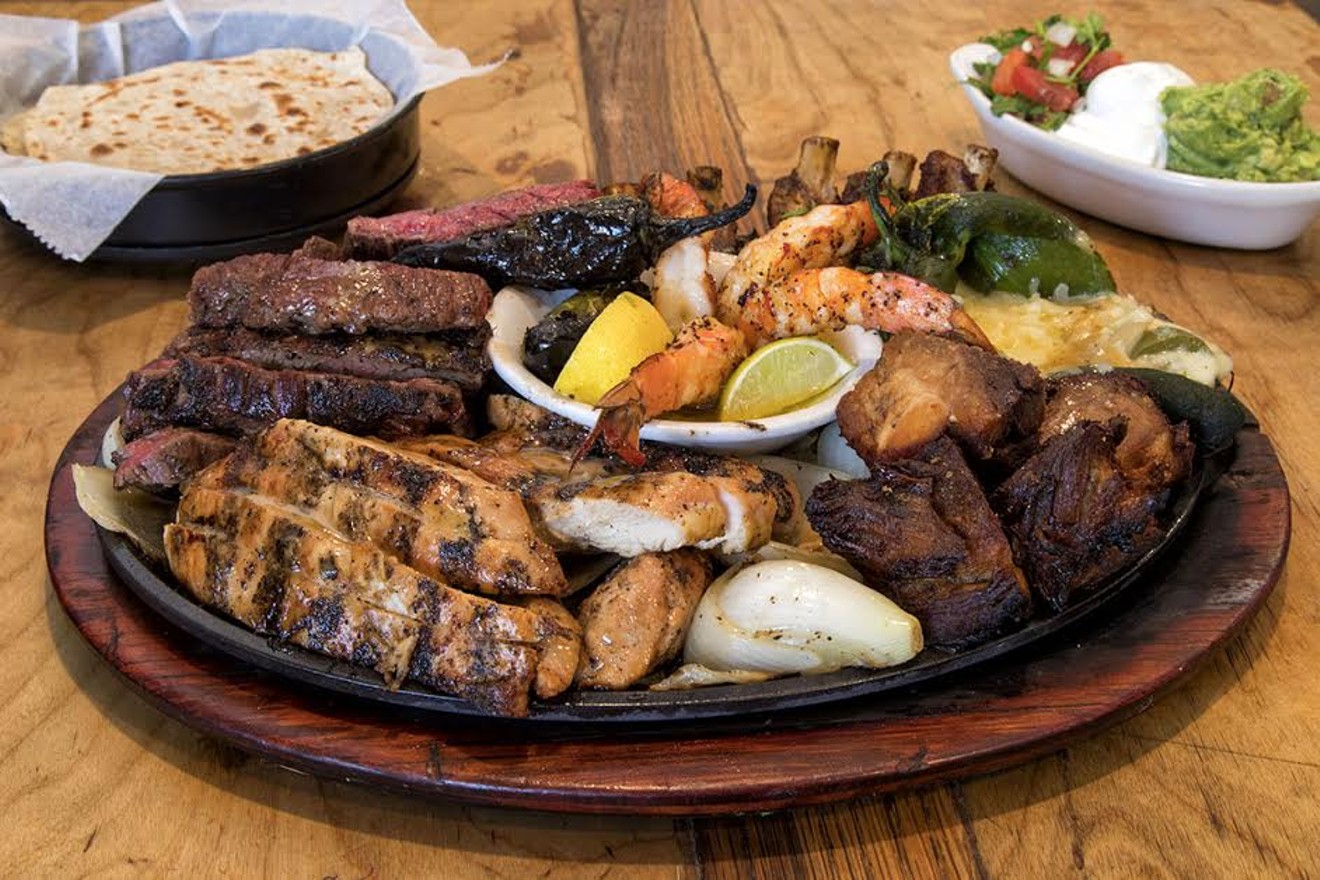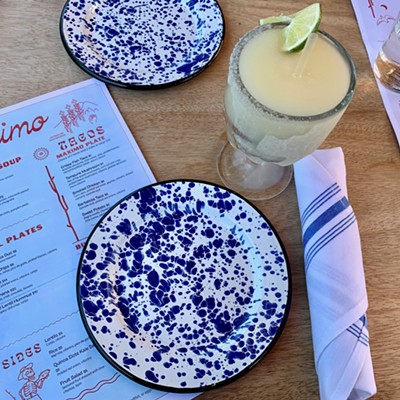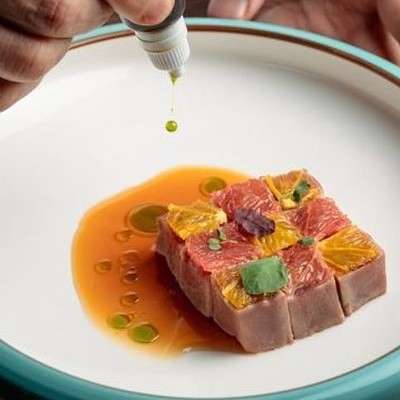
For an extra special treat, slater the queso at Cyclone Anaya's on housemade corn tortillas.
Photo by Troy Fields
“Chips and salsa,” Vienna Valencia Bement says, “can make or break a restaurant too. As a restaurant owner you’re like, what were we thinking; tomatoes are so expensive. But that’s something we’d never, ever charge for. That’s a welcoming.”
Anaya’s salsa is cool, refreshing and plump. It doesn’t easily spill off the corn chip, and may be the most perfectly spicy but balanced welcoming gift of all time. That’s until the queso hits the table. ?“If you want to know a little tip?” Bement says. “Order a side of corn tortillas with your queso and eat it that way. It’s a little messy, but so good.”
Bement and her partner, brother Rico Valencia, have had some time to perfect their family recipes. Their family’s eatery first opened in 1966 when Bement’s father, a famous wrestler from Mexico, Jesús Becerra Valencia, a.k.a. Cyclone Anaya, broke his back and his entertainment career ended. You can find his photo — handsome face, broad, bare chest, hairless and gleaming — on the wall of the restaurant’s seven locations today. He apparently once starred in an obscure Hollywood film as an Aztec god. Her mother, Carolina Berzeny, was a beauty queen from Ohio.
“Their first date was at the Old Mexico. He was in town wrestling and she was Ms. Houston Cowgirl Sweetheart. They met at the Rice Hotel doing interviews.”
With five kids to raise, her parents leased a space on Shepherd, an icehouse with 19 taps. “He had a bad limp,” Bement says of her father, but he still struck fear into the hearts of many, in particular Billy Gibbons, who saddled up one night after a high-school gig in search of a meal.
“What do you want, son?” Cyclone Anaya asked.
“Enchiladas,” the boy mustered.
Bement herself has made her fair share of them. “I’ve shredded cheese so many times, I’m surprised I still have finger tips. I come in today and see the automatic tomato chopper machine and I’m like, that’s just so not fair. I can dice an onion in two seconds, quicker than they can set up the chopper.”
As a kid, she started cooking in back with her mom, who started serving food so the men wouldn’t get too drunk. “We couldn’t serve liquor by the drink back then, but we had beer and wine.”
Her brothers chopped ice. Her grandfather chopped vegetables. Her cousins and aunts pitched in too. Her mother, they always joked, learned Spanish from the kids and how to cook from her husband and his Mexican mother.

The Summer Special was the first combination plate ever served at Cyclone Anaya’s.
Photo by Troy Fields
One thing Houstonians didn’t think was perfect was Cyclone Anaya’s early chili con carne, though. “My mom put beans in her chili. We were the only Mexican restaurant to put beans in our chili. Lots of complaints on that, but actually some people really liked it.”
El Tiempo, 5602 Washington
“Tex-Mex is right up there with chocolate chip cookies; it’s just one of the great comfort foods of the world,” Domenic Laurenzo says. It’s only 9 a.m. at his restaurant El Tiempo on Washington, one of seven locations, but servers are already wiping down tables and polishing silverware, getting ready for the oncoming lunch rush. For Laurenzo, a trained chef and the oldest grandson of “Mama Ninfa” Laurenzo, the Houston restaurateur credited with introducing fajita into the American culinary lexicon, Tex-Mex is a way of life.
You may know the story. The widow Mama Ninfa opens up in 1973, serving tacos al carbon in her struggling tortilla factory on Navigation, where she’s converted the front room into a five-table restaurant. Her kitchen catches on fire. She reopens, but the place stays pretty dead until about 1975. “Everyone that came in would rave about it, but it wasn’t until a city councilman — I don’t remember his name — went over there and had lunch that it reached critical mass,” Laurenzo says. After that it became the place to have business lunches in the downtown area and still is today, though the Laurenzo family is no longer involved.

Chef Domenic Laurenzo carries on his grandmother Mama Ninfa Laurenzo's legacy of exceptional hospitality at El Tiempo.
Photo by Troy Fields
Ninfa’s boom time was in the ’80s, but by 1996 the family faced financial difficulties and lost everything when creditors pulled the plug and forced them into bankruptcy. “We were trying to expand. We had restaurants all over the place.” Atchafalaya River Cafe. A pizza-by-the-slice spot, Bambolino’s. “We started messing with other stuff instead of sticking close to the knitting and doing what we do best.”
Mama Ninfa signed away her likeness and image. She signed a non-compete and never went back into the restaurant business. Laurenzo and his father, however, immediately plotted out their return while also operating a small burger business located, strangely, in the back of Ninfa’s on Navigation.
“The inspiration behind Ninfa’s was that my grandmother was always cooking her guisados and sharing it with the neighborhood. The aromas would flow through the neighborhood.” It’s the inspiration that Laurenzo has carried over to operating El Tiempo today, with many of the restaurant’s dishes inspired by her cooking.
There’s the carne guisada. The enchiladas Suizas, which come covered in Swiss cheese and a tomatillo sauce blended with heavy cream, turmeric, serranos and spices, all of it combining into a vibrant, practically fluorescent cream sauce. And the carnitas as well, fist-size hunks of pork butt lathered in minced garlic, salt and pepper, and cumin, and fried in pork lard for hours, almost like a braising, and then pulled out to cool. They’re then deep-fried to order.
“‘Fajitas and margaritas’ is our saying,” Laurenzo notes, harking back to Mama Ninfa, whose fajitas and margaritas were often considered a Houston standard. “She created an amazing legacy, one that I carry with me.”
But like the restaurant’s name — el tiempo means “the time” — the menu also continues to march forward. Today many customers believe the restaurant’s take on crab nachos, with lumps of jumbo crabmeat on top of individual chips covered in melty cheese and luscious beans, are the best nachos in Houston.

The Original Ninfa’s On Navigation made fajitas famous, and today the mixed grill platter is stilla must-order item.
Photo by Troy Fields
Over at Ninfa’s, the dining room is packed on a Friday at lunchtime. No surprise there. Law firms and big families crowd the room, tables of red and creamy green salsa all over the tables, and in the middle of it all, seated rather candidly behind an ill-placed post, sits famous Astros player Jose Cruz.
From the looks of it, I’m the only person who’s never been here before, and after one bite of queso flameado, that flambéed and sinful white cheese and chorizo stuffed tableside into a perfectly cooked flour tortilla, I understand why. If I’d grown up in Houston, I’d have demanded to be here as much as possible. That’s before the fajitas even hit the table.
When they do, a steaming mixed grill of Ninfa’s famous skirt steak, chopped against the grain, along with smoky, brilliantly tender chicken and the best quail I’ve ever tried — and in my former city, New Orleans, there is a lot of quail to be tried — grilled and not at all fussy, I realize I’m forever finished. I’m ruined. I will dream about tacos al carbon until I die.
Then come the new dishes by chef Alex Padilla. An octopus taco with spicy aioli. Salmon that gives at the lightest touch of fork tine, pairing perfectly with its bed of creamy, buttery polenta. This is Tex-Mex? It very well could be the future of it.
Currently run by Legacy Restaurant Group, the Ninfa’s institution continues to boom well into its 45 years of business, with a $2 million kitchen renovation in 2016 that left the restaurant boasting one of the biggest and baddest mesquite-fired, wood-burning ovens in town. Kitchen staff runs 30 deep — 37 if you count the tortilla ladies out front — headed by Padilla, who moved from Honduras to Houston as a kid and whose own mother worked for Mama Ninfa as a dishwasher back in the day.
Queso asado, or grilled cheese, is a highlight. The white cheese arrives on the table thick as Texas toast, char marks etched into its fleshy surface like prison bars and the square of it cut bunny style, as my grandmother would have called it, down the diagonal. With a dash of accompanying tomatillo, pickled jicama, pineapple and onion, it’s absolutely phenomenal, and probably the lowest-calorie option for queso on the menu.
“That’s Tex-Mex,” Padilla says, looking at my serving on a flour tortilla, the way I’ve neatly arranged it with all of its side items, including one long stem of cilantro. He serves his queso on a ripped shred of corn tortilla with just a light dollop of tomatillo sauce in classic chef fashion, no time to spare. “This,” he says, “is Mexican.”
While Padilla is busy turning folks on to new, progressive dishes with ingredients such as sweetbreads, adobo rabbit and duck confit and high-end reposado, mezcal and sotol, folks in search of old, off-menu items can still find them at Ninfa’s thanks to longtime server Kady Lopez, who has been on the floor for 41 years, a menu-whisperer of bygone eras. Can’t find the dish you loved in 1979 or 1989? She’s your lady.
“People say, ‘I wanna have enchiladas the old-fashioned way.’ The other day I had a customer who wanted something called Chicken Acapulco. There’s a sauce called Dolly sauce, white sauce, which came from Jack Laurenzo’s wife, his first wife. People ask for it; it’s not on the menu anymore, but I give it to them because we have the ingredients. I always give it to them.”
Lopez’s own sister, Tina, has worked at Ninfa’s as a server for 35 years, and co-worker Omar Cepeda for 30. Many customers call them on their cell phones to reserve tables, Lopez tells me, especially on the way home from the airport. Apparently that’s a thing — calling in for your queso fix the second you touch down on the tarmac. But if you don’t have Lopez’s number, don’t worry.
“The baldheaded guy is on vacation,” she says, referring to Cepeda. “But he’ll be back next month.”

Tex Mex expert Robb Walsh stands before his extensive collection of Felix memorabilia at El Real on Westheimer.
Photo by Troy Fields
Back in Montrose, Walsh takes me up to El Real’s second-floor dining area, where Houston institution Felix has been preserved and put on display, from its cases of memorabilia and old ephemera to the dining chairs and the very doors that resided in its dining room for decades up the block where Uchi is now located. I’ve heard that people who ate at Felix would never venture to other Tex-Mex eateries.
Back downstairs, I chow down on The Roosevelt Special, an enchilada with fried egg served over it, and think about what Walsh said, how it all started with chili con carne. If that’s the case, the chili gravy here is a testament to the history of Tex-Mex. It’s a meatier version of the roux-based gravies around town, and the house-ground seasoning powder makes its fresh presence known. I take turns eating the enchilada, scooping up queso with chips and taking sips of a top-shelf margarita. This, I believe, is the essence of Tex-Mex.

The San Antonio-style puffy tacos packed with smoked chicken are a no fail lunch at El Real.
Photo by Troy Fields
That’s when a small plate of fajita arrives.
Walsh tells me that not many places still actually serve fajita, or the “little belt” of outside skirt, because of cattle regulations — something to do with the meat being redesignated as offal back in the ’90s and being sold in large part to Japan and other parts of Asia, instead of here in the States. There are places, he informs me, that serve meat loaded with enzymes that will keep tenderizing the meat until it turns to mush, even after it’s cooked.
At El Real, you will still be served the hard-to-find outside skirt, cut against the grain. Everything here is traditional. I take a bite and another. It’s delicious. Walsh wants me to guess the ingredients in the marinade, but the only one I can pick up is pineapple.
I ask him what his favorite Tex-Mex restaurant is and he responds that it’s his own, but I’m pretty certain his allegiance just lies in the history of Tex-Mex itself.
When I ask if he thinks the cuisine will continue to change, to become more progressive, he gives me a resounding “no” anyways. Then he tells me the other ingredient in the marinade. It’s not a rare chile or some German’s mass-marketed seasoning blend or even a Canary Islander’s exotic cumin spice that dates back to the border towns you might pluck right out of some old, gritty Western film. No. It’s soy sauce.











